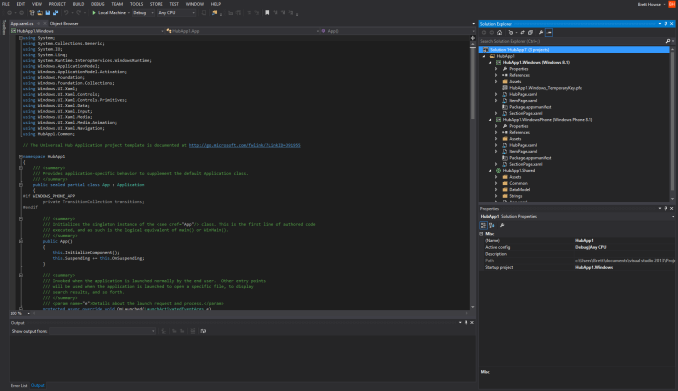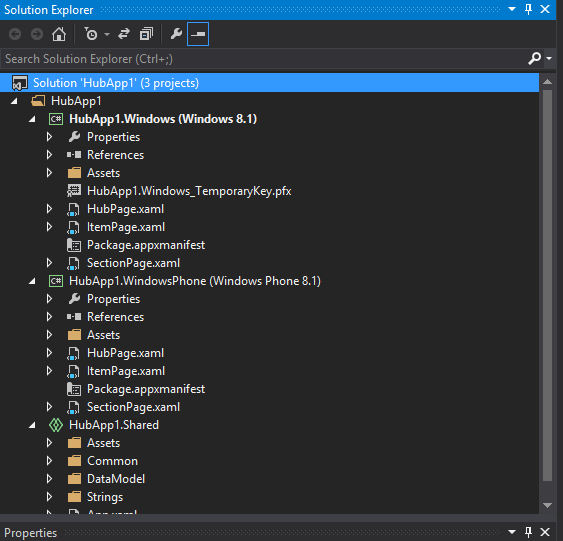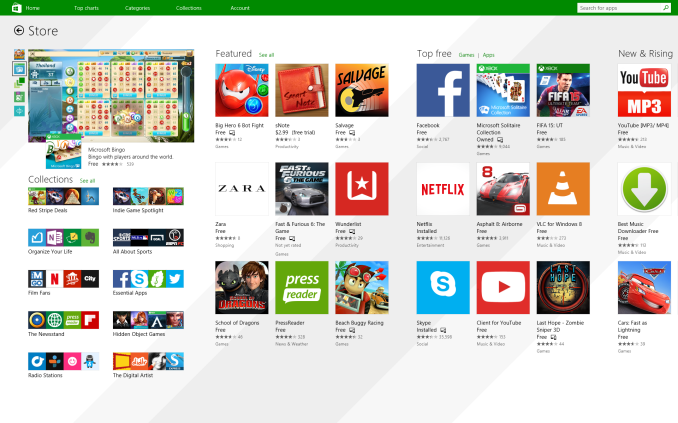Windows 10 Technical Preview First Impressions: The Return Of The Desktop
by Brett Howse on November 13, 2014 8:00 AM EST- Posted in
- Software
- Microsoft
- Windows 10
Universal Apps and the Windows Store
We just got done discussing why a single user interface for the OS across multiple devices is not always the ideal solution, so of course the obvious question with Universal Apps is why would you want it with the app model instead? Thankfully this is not the case although the term Universal App might lead people to believe they are attempting to have a single app target all of their platforms. The truth of the matter is that Universal Apps are Universal in the sense that they share a common app store.
If Microsoft is going to have Windows 10 succeed on desktops, laptops, tablets, phones, and even Xbox One, they need developer buy-in. A platform without apps is not much use to anyone. With the Universal App, they can bridge all of their platforms with a single App in the store. Under the hood, each app is created with a common framework of code, as well as multiple user interfaces in order to tailor the experience to the correct device type. Below is a screenshot of Visual Studio – Microsoft’s developer tools – with a new Universal App about to be created.
 Visual Studio Showing a Universal App Project
Visual Studio Showing a Universal App Project
As you can see, there is a shared portion of code, and then a project for the UI for Windows 8.1, and Windows Phone 8.1. Xbox One is not available yet, but should be added in a future release of Visual Studio.
A close up of the projects
But you may be wondering why any of this is necessary. Windows has the largest selection of applications of any system ever. That is of course true, and the Win32 framework has served both Windows and its users well over the years. But with the new WinRT framework there are some big advantages. First, it can be written to in multiple languages including HTML. WinRT supports C++/CX, C#, VB.NET, and HTML scripting with JavaScript and TypeScript. The security model for WinRT apps is a lot different than Win32, with all WinRT apps running in a sandbox mode for higher security. Unlike apps written in .NET, WinRT is native code, which should result in better performance. Contracts and Extensions are also new to WinRT, and allow apps to share data while still being in a sandbox. One of the biggest advantages of WinRT is that it is DPI aware, and can automatically scale apps appropriately based on screen size and screen resolution. Here, as we know, Win32 apps can struggle even though there are solutions in place.
Adobe Touch WinRT (left) vs Adobe Reader Win32 (right) on HiDPI display
One of the biggest disadvantages of WinRT is that it is only available on Windows 8 and newer devices. With Windows 8 struggling in the market as compared to Windows 7, the user reach of a developer targeting WinRT apps in the Windows Store would be for a subset of the total user base. With Windows 7 having over 50% of the desktop OS market share to itself, this is going to be an issue.
With Windows 10, Microsoft is certainly targeting Windows 7 users. If they can convince them to upgrade to the latest version of the operating system, then the new environment will have a much larger target base and will hopefully encourage developers to target the Windows Store. We have not heard of any upgrade promotions or pricing yet, but this is one of the biggest advantages Apple has had over the years. Their user base generally upgrades the OS at a much faster uptake than Windows. This allows developers to utilize newer APIs in the latest versions of their operating systems and keep the platform progressing. Microsoft has already had to deal with people being stuck on Windows XP, and they must be wanting to avoid that with Windows 7.
Since we are discussing Universal Apps and their advantages, one of the biggest advantages is the Windows Store. With Microsoft hosting the entire download and purchase of all WinRT apps, having user settings and apps sync from one device to another is much easier. One of the greatest experiences with Windows 8.1 is signing into a new PC for the first time. When you log in with your Microsoft Account, the system asks you if you would like to copy the devices and apps from one of your other devices, or if you want to start with a clean machine. If you choose a previous machine, all of the settings, wallpaper, Start Screen layout, and Windows Store apps are synced to the new device. In the case of Windows Store apps, the app itself is listed on your Start Screen, but it is not downloaded until the first time you select it. This avoids a situation where you will significantly delay the initial login time with a massive download, as well as avoid filling the available storage with apps you may not need on that particular device.
Also, like modern tablet and smartphone OSes, WinRT apps from the store are automatically kept up to date by the store. This avoids a lot of the issues with viruses and malware attacking an older version of a product since in theory it will not be around any longer.
The one thing missing from this are the older Win32 apps on the desktop, because they are not available in the Windows Store. Prior to Windows 10, desktop apps could be listed in the store, but the store would then link to the developer’s website to allow you to purchase and install the app. With Windows 10, rumors are that desktop apps will also be available and managed through the Windows Store. Assuming this does happen, then this will be a major boon to users. Desktop apps should in theory also be able to be kept up to date using the Windows Store which should cut back on the number of outdated pieces of software targeted by malware.
The Windows Store is a key piece of Windows 10. Universal Apps can be made available for multiple platforms through the store, and, if the rumors are true, even desktop apps will be available through the store. This should make the Out Of Box Experience (OOBE) very good for users with a Microsoft Account. The WinRT framework has not yet had the killer app written for it, so hopefully with Windows 10 the framework will be expanded to allow for more powerful apps to be created.













198 Comments
View All Comments
Pork@III - Thursday, November 13, 2014 - link
Now back and aero interface and become ... well. For excellent results, however, it is necessary to hide the "Metro" even aside. It is still more harm than help.metayoshi - Thursday, November 13, 2014 - link
With regards to the Share feature on desktop, does the Windows Photo Viewer also have a share button? That would definitely be useful for sharing to Facebook or Twitter (or Instagram, if they ever implement a Windows app) instead of having to share from the Windows Explorer every time.Brett Howse - Thursday, November 13, 2014 - link
The "Photos" app supports this. I would think it unlikely they would add the Share contract in to the old one but at this rate - who knows.Chloiber - Thursday, November 13, 2014 - link
As a person who works in a small start up that uses a lot of Microsoft hardware and software, the new business features sound awesome. We are getting to a point where we need management systems but many existing ones are simply too expensive for only a handful of people and require (again) hardware, software and someone probably needs to invest several days or weeks to set things up correctly. So this really comes in handy and I'm looking forward to it!Regarding the server OSes, I think they did many things right with Windows Server 2012 R2, but there are still some things (usability wise) that need improvements.
Taurus229 - Thursday, November 13, 2014 - link
I still say that Windows 7 is much more user friendly. Just look at where Microsoft has placed the shutdown, restart button. Common sense says that Microsoft did not put much thought into that change! Microsoft still has to make it as user friendly as Windows 7 to achieve acceptance.Chloiber - Thursday, November 13, 2014 - link
I have to agree on this one. I always used my keyboard with Windows 7 to shutdown/restart/standby my machines. Win -> ArrowRight -> (ArrowUp/Down) -> Enter. It was terrible in Windows 8 / Windows Server 2012 and got a bit better in 8.1 / 2012 R2. In Windows 10 it's basically the same as in 8.1...inighthawki - Thursday, November 13, 2014 - link
Or, you know, make it customizable? Let the user drag and drop components onto their start menu however they see fit. Isn't that the entire goal - start is personal?lilmoe - Thursday, November 13, 2014 - link
I love the way windows snap right and left now. When you snap a window to the left, re-size it, and try to snap another to the right, the new window will snap filling all the space made available by re-sizing the first window. Cool.This is great when you're trying to snap 2 windows only. However (and I did write to Microsoft about it), when you're trying to snap 3 or more windows (columns of windows), it would be nice if the third window automatically snapped in the vacant space made by resizing any of the previous ones. Would be awesome, especially when you're trying to display several windows together since screens are really wide nowadays.
crabperson - Thursday, November 13, 2014 - link
I never understood why the app switcher mechanism in Windows 8 wasn't fused with the classic taskbar. It seems like there's a 'touch' taskbar you can pull up using a gesture, and a separate taskbar for windows on the desktop. It makes even less sense now that apps show up on both in 8.1, yet the Desktop is still an app on the touch version.Couldn't you just swipe from whatever side of the screen the taskbar is on to see the app previews (or even the existing aero previews), and keep swiping to pull the app to the foreground, whether its a fullscreen touch app or a standard application window? Then the charms and menu gestures can be moved to whatever sides of the screen that are free, for the 5% of people that move the taskbar around.
stephenbrooks - Sunday, November 16, 2014 - link
Glad I'm not the only one who wondered why they weren't more unified.While we're unifying things, why not have an option for the Win8-style Start screen to *be* your desktop? It basically replaces "putting a load of application shortcuts on your desktop" anyway.